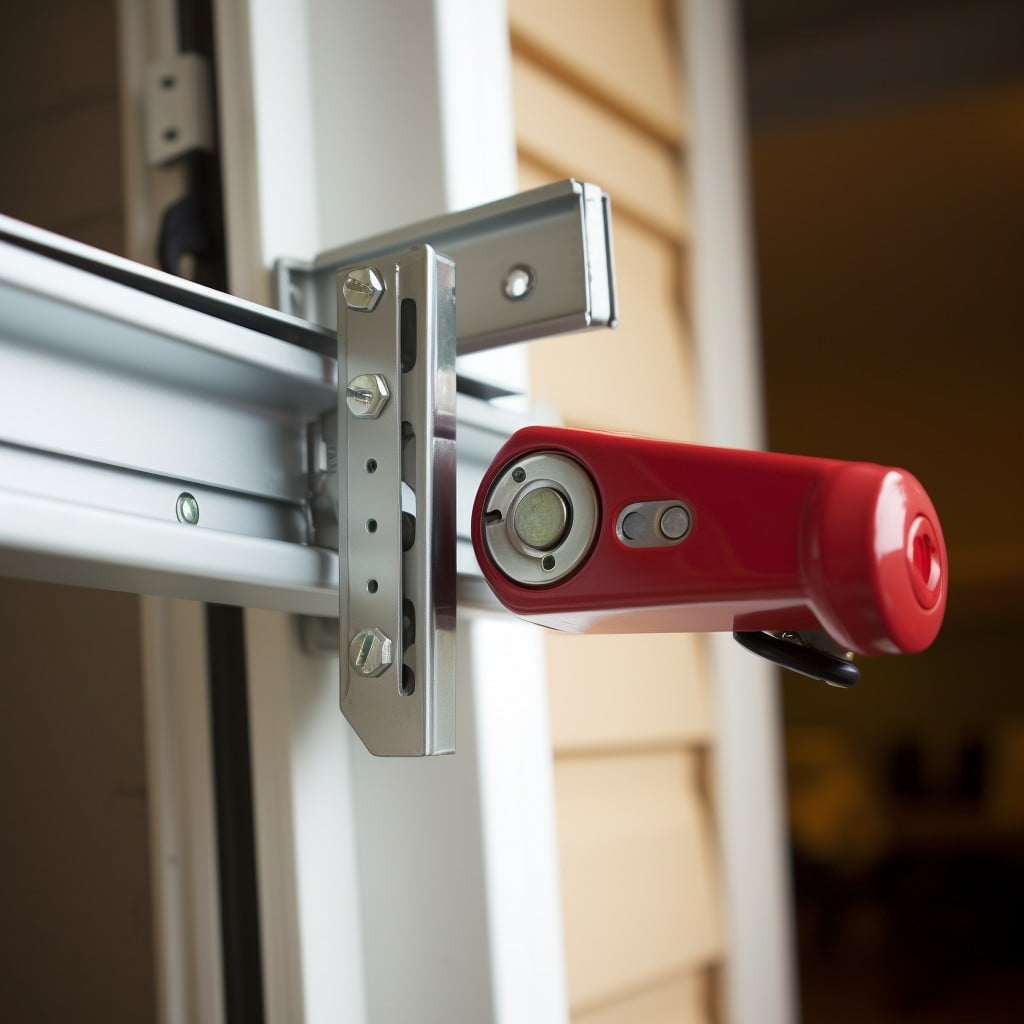Discover the simple steps to lock your garage door manually, ensuring optimal safety and security for your home.
If you’re looking to manually lock your garage door, you’ve landed on the right page. This article covers the process in detail, ensuring you can secure your garage without any hassles.
Whether your automatic opener is malfunctioning or you simply prefer the old-fashioned way, knowing how to lock your garage door manually is a valuable skill.
Read on to discover the step-by-step guide, filled with useful tips and precautions to ensure your garage door is locked securely and safely.
Key takeaways:
- Disconnect power source to start manual locking process.
- Power failures and mechanical issues may require manual locking.
- Electric garage doors can have built-in manual locks.
- Find the locking mechanism for your garage door.
- Pull the emergency release cord to engage manual lock.
Disconnecting the Power Source From Garage Door

To start the manual locking process, disconnecting the power source is essential. This simplifies the operation and ensures safety.
First, locate the power source of your garage door – typically, this will be an electrical outlet in your garage. Secondly, carefully remove the garage door opener plug from the outlet. Remember, you’re dealing with electricity, so safety should always be a priority.
If you have a battery backup system, ensure it’s also disconnected. Consider tagging or marking the power cord to remind you (or others) it’s disconnected intentionally.
Why You Might Need to Lock Garage Door Manually

Several scenarios call for the manual locking of a garage door. Power failures, for instance, compromise the function of an electric door opener, necessitating a switch to manual operation. Furthermore, mechanical issues, such as a broken chain or misaligned track, may render the automatic unlocking ineffective.
Notably, security is a primary concern when leaving your home unattended for extended periods, like during a vacation. Manually locking your garage door during such times provides an extra layer of security against potential burglars. Lastly, if you’re conducting maintenance on your garage door system, manually locking becomes paramount to preserve safety during the process.
In the following sections, we will explore how to find the locking mechanism and walk you through the process of manually locking your garage door.
Can I Lock My Electric Garage Door?

Electric garage doors, often equipped with automatic openers, are designed with functionality and ease in mind. However, the question is whether these electric doors can be manually locked?
1. Built-in Manual Locks: Many electric garage doors come with built-in manual locks. These are usually located centrally on the door and can be engaged by turning a key or handle.
2. Disconnect From the Opener: To manually use this lock, you may need to disconnect the door from the automatic opener. This is typically accomplished by pulling a dedicated disconnect switch, handle, or cord.
3. Manual Locks for Added Security: Additionally, some homeowners choose to install their own manual locks. This can be a useful measure for added security, especially during extended periods when the home is unoccupied.
4. Consistent Operation: While manual locking does require additional effort compared to automatic locking, it provides a reliable way to secure your garage.
Remember, always disengage any manually applied locks before reconnecting your garage door to an automatic opener to avoid potential damage.
Finding the Locking Mechanism for Garage Door

Garage doors typically contain a mechanism offering manual locking capabilities. Locating this mechanism proves crucial to securing your garage manually.
Usually, you’ll find this mechanism situated inside the garage with a handle, latch, or knob affixed. Some models position it centrally while others have it near one end of the door. It might differentiate itself from the rest of the hardware with features like a metallic shine, graspable structure or noticeable lockhole.
Once you’ve located this crucial element, you’re one step closer to securing your garage door manually. Furthermore, always ensure this mechanism is in functional and good condition. A stuck or rusty lock won’t offer you the security you need, so consider occasional maintenance checks.
Turning the Handle On the Garage Door
First off, locate the handle, typically positioned in the middle of the door. Rotate it in a clockwise direction until you hit resistance. This resistance is a sign that the internal locking mechanism is engaging. Continue turning until you can’t anymore.
Now, proceed to manually slide the two side locks into the vertical track. If these locks don’t slide easily, check if there’s anything obstructing their path and remove it. The door is locked once these bolts align with the holes in the track. Always remember not to exert too much force in doing commands to avoid damage.
This method gives a robust layer of security to the garage door. It’s the first line of defense and a beneficial deterrent against opportunistic criminals. Nevertheless, some doors might not have this mechanism. If that’s the case, you might need to install it separately or consider alternative locking methods.
Pulling the Cord to Manually Lock the Door
To engage the manual lock, a key focal point is the emergency release cord. Typically, this is a red rope attached to the door’s trolley — the mechanism responsible for pulling your door up and down. Start by disconnecting the automatic door opener. Next, locate the cord, and provide a firm pull.
Bear in mind, the door needs to be in the closed position before proceeding. Be extremely careful that it doesn’t fall or slam during this process, as it can lead to damage or pose a safety risk. Always ensure there are no obstructions in the door path and keep clear to avoid potential harm.
After pulling the release cord, the door disconnects from the trolley, enabling manual operation. This way, you can slide the door along its track and set the manual lock at your convenience. Remember, once in this mode, the door solely relies on the manual lock for security.
Moreover, ensure frequently checking the condition of the release cord. Regular wear and tear can make it less reliable over time. Should it ever become worn or damaged, consider replacing it immediately to maintain a functional manual locking option.
Making Sure Your Garage Door Is Clearly Locked
Once the manual locking process is complete, it’s essential to confirm that the door is secure. A few necessary steps will empower you with that peace of mind.
Firstly, attempt to open the door using your automatic opener. If the lock is properly engaged, the door will remain in place despite the activity of the opener.
Next, check for any visual clues. The manual lock typically extends a bolt from the door into the garage’s side rails that, when correctly placed, should be visibly noticeable.
Lastly, perform the physical test. Try lifting the garage door from the bottom. A well-secured door will resist your efforts.
Remember, each garage system is different, and yours may have other unique indicators that the manual lock is correctly engaged. Always refer to your owner’s manual for additional verification steps. After all, the important note here is ensuring an actual lockdown so that you can sleep with peace, knowing that you’ve secured one of the most prominent entries into your home.
Securing Your Garage Door While On Vacation
Taking extensive measures to secure your garage door while away is a crucial step towards complete home safety. First, disconnect the automatic door opener to prevent unauthorized remote access.
Second, always apply a padlock on the manual latch if possible. This adds another layer of difficulty for burglars attempting to break in.
Third, shield the windows or install frosted glass to obstruct visibility. Keeping the interior of your garage hidden removes the temptation for potential thieves.
Finally, consider using home security systems or smart garage door controllers. This technology allows you to receive instant security alerts and monitor your garage remotely. Remember, a well-secured garage door is a key deterrent to unwanted intruders.
FAQ
Why is my garage door not locking?
Your garage door may not be locking due to obstructions or raised elements on the floor disrupting the alignment of the lock bar.
How do you secure an up and over garage door from the inside?
An up and over garage door can be secured from the inside by using the built-in locking mechanism, typically activated with a simple switch.
What are some effective security enhancements for a manual garage door?
Installing durable locks, adding security lights, investing in an alarm system, and using deadbolts are effective security enhancements for a manual garage door.
How can you retrofit an old garage door with modern locking mechanisms?
Retrofitting an old garage door with modern locking mechanisms can be accomplished by replacing the existing lock setup with a new, advanced lock system, which may include electronic keypad locks or smart locks that can be controlled remotely.
What are the common mistakes to avoid when locking a garage door manually?
Common mistakes to avoid when locking a garage door manually include not testing the lock before leaving, forceful turning that can damage the mechanism, and neglecting regular maintenance checks for wear and tear.